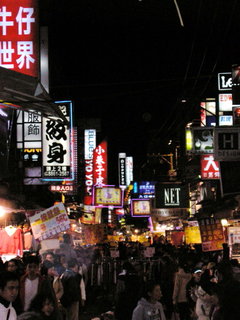- Night markets in Taiwan
-
Night market in Hualien, Taiwan.

Night markets in Taiwan are street markets in Taiwan that operate in urban or suburban areas. They are similar to those in areas inhabited by ethnic Chinese, such as Southeast Asia. A few such as Huaxi Street Tourist Night Market (or Snake Alley) utilize purpose-built marketplaces but most occupy either sidewalks (pavements) adjacent to streets or entire streets that are normal thoroughfares by day. Some night markets in smaller side streets or lanes feature retractable roofs. Most of the markets operate daily and feature a mixture of individual stalls hawking clothing, consumer goods, xiaochi (snacks or fast food; siaochi in Tongyong), and specialty drinks. The atmosphere is usually crowded and noisy with hawkers shouting and fast-paced music playing over loudspeakers.
Night markets in Taiwan today
Night markets in Taiwan have become famous for their xiaochi foods (xiaochi roughly translates to "small eats" or finger foods). Served in portions similar to Spanish tapas, these dishes are often taken as carry-out items, but many sellers provide a few small folding tables with stools. These dishes are offered at low prices, usually around $30 to $50 NTD (≈$1-$1.75 USD). Visitors whom expect to eat enough to be full during a trip to the night market will usually spend around $100 to $300 NTD (≈$3-$10 USD). Most night markets also have some small restaurants which provide a number of simple courses that allow people to finish a full meal without having to eat their way through the entire market.
Though some of the xiaochi foods available will change from year to year with passing fads, certain xiaochi foods such as oyster omelets (蚵仔煎 ô-á-chian), chicken shawarma (沙威瑪 shāwēimǎ), and stinky tofu (pronounced tso-dofu) (臭豆腐 chhàu tāu-hū) persist, and have become staples in many night markets. Sometimes, the night markets of a city, or even just one particular market within that city, become well known for a certain type of food that is unique to the area, or prepared particularly well there. For example, Tainan has become known for its noodles (擔仔麵 tàⁿ-á-mī) and "coffin cakes" (棺材板 guāncáibǎn), bread baked into the shape of a coffin, hollowed out, and then stuffed. In Taipei, the Shilin night market features a particular store which is well known for serving tasty fried chicken breast, in large portions, and for a low price. There is also the Iron-egg (鐵蛋) from Tamsui.
In recent years, many of the night markets have become popular tourist destinations among sightseeing foreign travelers. It’s common to see many travelers with cameras, snapping photographs amidst the crowds (and of the crowds) within the streets. Some of the night markets, such as the Shilin (at Yuanshan, Taipei) and Shida night markets (next to National Taiwan Normal University) are among the first places that Taiwanese students will bring international students for a cultural experience.
In addition to food, night markets feature various forms of entertainment and a lot of shopping. Numerous products for sale include clothes, bags, shoes, trinkets, kitchen items, etc. Carnival-style games are typically available to play for the price of a few coins. The night market in Tamsui is especially well known for featuring traditional carnival games such as balloon shooting, net fish, shooting marbles, and an assortment of mini games that could only have otherwise been seen many years ago.
See also
References and further reading
Shuenn-Der Yu. "Hot and Noisy: Taiwan's Night Market Culture." The Minor Arts of Daily Life: Popular Culture in Taiwan. David K. Jordan, Andrew D. Morris, and Marc L. Moskowitz, eds. Honolulu: Univ. of Hawai'i Press, 2004.
 Republic of China (Taiwan) topics
Republic of China (Taiwan) topicsSociety Administration Culture Aborigines · Cinema · Communications · Cuisine · Holidays · Literature · Media · Music · Night markets · Sports · Tea · TourismEconomy Geography History History of Taiwan · Taiwan after World War II · Years in the Republic of China · Timeline of Republic of China history · Timeline of Taiwanese historyCategories:- Night markets of Taiwan
Wikimedia Foundation. 2010.


